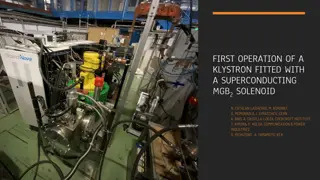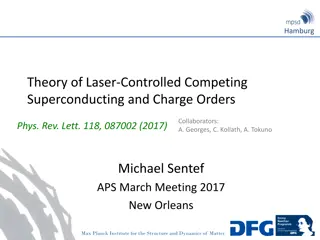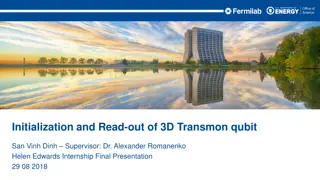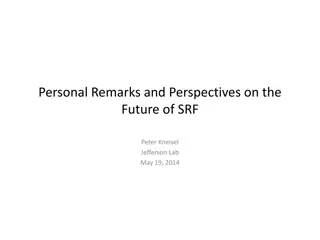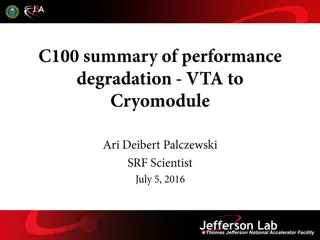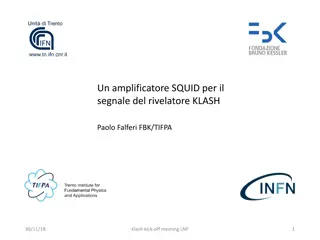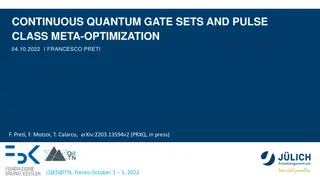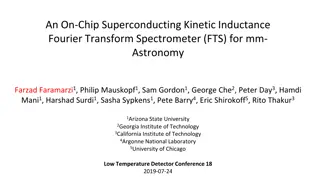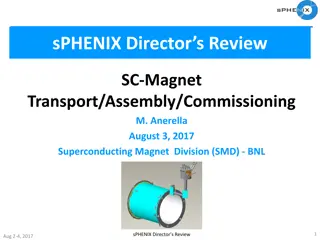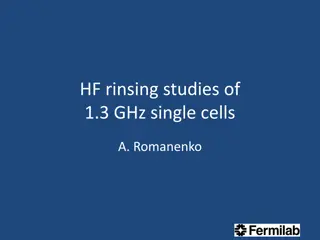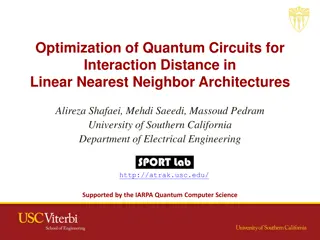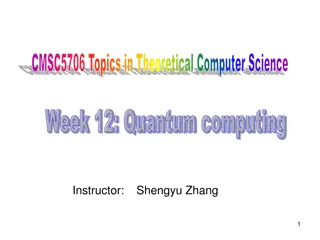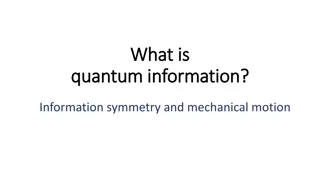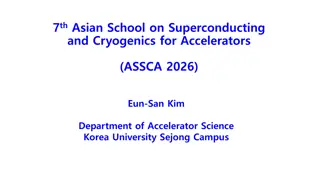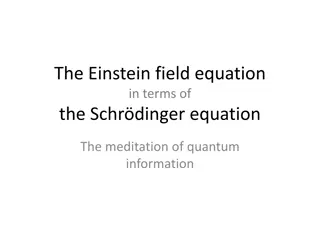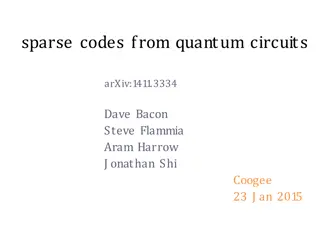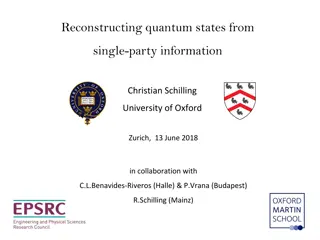Advanced Instrumentation and Diagnostics for Superconducting Magnets at CERN
Explore the crucial needs for instrumentation and diagnostics at CERN, focusing on superconducting magnets. Topics include voltage and strain measurements, vibration analysis, temperature sensing, quench detection, and magnet form factor considerations. The importance of advanced diagnostics and com
8 views • 23 slides
Advancements in Superconducting Solenoid Technology for Klystrons at CERN
Research highlights the first operation of a klystron equipped with a superconducting MgB2 solenoid, aiming to enhance efficiency and sustainability of klystron systems. The focus is on integrating novel solenoid designs, such as those proposed by A. Yamamoto, to optimize klystron performance at CER
10 views • 18 slides
Innovative Superconducting Cavities Research Project Overview
This project, funded by the European Union's Horizon 2020 program, focuses on innovative superconducting cavities coated with superconducting films. Objectives include optimizing production procedures, testing prototypes, and reducing costs. Tasks involve coordination, strategy development, and achi
4 views • 9 slides
Laser-Controlled Competing Superconducting and Charge Orders in Transition Metal Dichalcogenides
Hamburg Theory of laser-controlled competing superconducting and charge orders explores the use of lasers to manipulate the ordering mechanisms in transition metal dichalcogenides, leading to ultrafast switching and the induction of new states of matter. This research delves into generic mechanisms
1 views • 13 slides
3D Transmon Qubits in Quantum Computing
This document delves into the initialization, read-out, and measurement techniques of 3D transmon qubits as integral components of quantum computing. It covers the underlying principles of superconducting qubits, SRF cavity utilization, and the roadmap for improving quantum memory and coherence time
5 views • 12 slides
Investigation of Self-Organized Criticality Dynamics in Low Energy Threshold Ionization Detectors
Exploring the effects of energy accumulation in materials in detectors for coherent neutrino scatter, dark matter searches, and superconducting sensors and qubits. Focus on condensed matter effects, responsivity, background, and a hypothesized universal condensed matter mechanism. Touches on energy
2 views • 16 slides
Insights on the Future of SRF Technology by Peter Kneisel at Jefferson Lab
Peter Kneisel reflects on the past and present advancements in superconducting radiofrequency (SRF) technology, debunking the notion that Niobium has reached its limit. He discusses ongoing improvements in SRF cavities, surface treatments, and fabrication techniques, highlighting the need for cost r
2 views • 20 slides
Magnetization, Decay, and Error Fields in HTS Accelerator Magnets
The research conducted at The Ohio State University focuses on understanding the magnetization, decay, and influence of error fields in high-temperature superconducting (HTS) accelerator magnets. The study explores the impact of different superconducting materials such as Nb3Sn, YBCO, and Bi:2212 on
2 views • 21 slides
Quantum Circuit Simulations and Electromagnetic Analyses in Quantum Photonics
Explore the world of quantum photonics with insights into two-qubit photon counters, jointed cavities, qubit pads, and quantum circuit simulations. Ansys simulations and experimental data by researchers Alessandro D'Elia and Claudio Gatti provide in-depth analysis of quantum phenomena. Discover the
2 views • 7 slides
Long-term Operation of Superconducting Triplet Quadrupoles (STQ) with Cryocoolers at RIKEN
Introduction to the operational experiences, maintenance, and long-term operation of the Superconducting Triplet Quadrupoles (STQ) with cryocoolers for the BigRIPS In-flight Separator at RIKEN. Details include standard operation of SC magnets, unique features of BigRIPS and RI-beam delivery lines, S
1 views • 16 slides
Quality Control and Testing Procedures for Superconducting Radiofrequency Cavities
The presentation highlights the rigorous processes involved in qualifying superconducting radiofrequency (SRF) cavities for high-performance applications. Each cavity undergoes a detailed qualification process, including BCP treatment, electropolishing, and high-pressure rinsing, to ensure optimal p
4 views • 18 slides
Superconducting Quantum Interference Device (SQUID)
The Superconducting Quantum Interference Device (SQUID) is a crucial component for detecting signals in devices like the KLASH detector. By combining Flux Quantization and Josephson Tunneling, the SQUID operates based on key principles such as the Josephson Equations and the Flux Quantum. Through ca
3 views • 23 slides
Quantum Error-Correcting Codes and Subsystem Codes
Quantum error-correcting codes (QECC) play a crucial role in protecting quantum information from errors. Stabilizer codes with fault-tolerant error-detecting circuits can lead to the construction of resilient subsystem codes. These codes involve encoding logical qubits into physical qubits and error
3 views • 26 slides
Quantum Computing: Quantum Gates, Bits, and Applications
Explore the world of quantum computing with this detailed guide covering quantum bits, gates, their applications, and the advancements made in the field. From classical bits to qubits, Bell states, and quantum gates, discover the fundamental principles that drive quantum computing forward.
0 views • 37 slides
Optimizing Continuous Quantum Control with Variable Parameters
The research delves into solving quantum optimal control problems with versatile system parameters through robust and analytical approaches. It explores optimizing figures of merit in quantum systems with varying Hamiltonian and pulse parameters, showcasing solutions for single-qubit and two-qubit s
2 views • 18 slides
On-Chip Superconducting Kinetic Inductance Fourier Transform Spectrometer for mm-Astronomy
This innovative on-chip spectrometer offers a compact solution for mm-wave astronomy research, utilizing superconducting kinetic inductance technology. Learn about the motivation behind its development, the concept of kinetic inductance in superconductors, and the advancements in non-linear kinetic
2 views • 11 slides
sPHENIX Director’s Review
In this review, the Superconducting Magnet Division (SMD) at BNL oversaw the preparation, shipment, and installation of a superconducting magnet. Key personnel and detailed processes involved in the project are highlighted. The focus was on ensuring the safe transport and successful commissioning of
4 views • 14 slides
Superconducting Cable for CBM Magnet
This content focuses on the development of a superconducting cable for the CBM magnet by Nikolay Mezentsev at BINP. The advancement in superconducting technology is crucial for enhancing the efficiency and performance of magnets in various applications, including the CBM project. This research highl
1 views • 5 slides
Quantum Technologies Infrastructure Discussion
Group discussions on infrastructure needs for solid-state qubits, defects, optics, and quantum materials, emphasizing collaboration, access modes, and multinational sources to address industry interest and alignment with research programs.
2 views • 6 slides
Photonics & Quantum Technology Workshop
Join the Quantum Careers & Education Panel: delve into quantum information science, applied technology products, recent job examples, and future opportunities in the field. Explore superconducting qubits, nanophotonics, and more with industry experts
2 views • 14 slides
Quantum Computing: Qubits Fabrication Approaches and Challenges
Describing the behavior of particles at small distances and energy scales, quantum mechanics encompasses superposition, coherence, entanglement, and measurement. Quantum computing leverages interference, superposition, and entanglement to achieve unprecedented computational power with qubits. Variou
3 views • 21 slides
High Frequency Rinse Studies for Niobium Superconducting Cavities
Explore the impact of HF rinsing on optimizing medium Q0 in niobium superconducting cavities through anodizing experiments and rinse procedures. Discover results showcasing improvements in Q0 values and high field Q-slope after multiple rinse cycles.
0 views • 13 slides
Quantum Circuit Optimization for Linear Nearest Neighbor Architectures
Explore how quantum circuits can be optimized for interaction distance in linear nearest neighbor architectures, presented by researchers from the University of Southern California. The study focuses on geometric constraints, motivation behind quantum computing, quantum circuits and qubits, physical
0 views • 12 slides
Quantum Computing: Algorithms, Qubits, and Gates
Explore the world of quantum computing through 3-qubit Grover's algorithm, quantum bits, Bloch sphere, entanglement, logic gates, matrices, and Grovers' algorithm. Learn about the advanced principles that power quantum computers and their potential applications.
1 views • 19 slides
Introduction to Quantum Computing: States, Evolution, and Measurements
Dive into the fascinating realm of quantum computing with an exploration of states, evolution through unitary transformations, and measurements in quantum systems. Understand concepts like pure states, ket notation, qubits, and how measurements impact quantum bits. Explore the power and principles o
3 views • 49 slides
Quantum Information and Qubits: Insights into Mechanical Motion
Explore the fascinating realm of quantum information and qubits, delving into the interplay between information, symmetry, and mechanical motion. Discover how qubits are represented in Hilbert space, as well as their geometric interpretation as points on a 3D unit ball. Gain a deeper understanding o
0 views • 25 slides
Compact Purcell Filter Design for Superconducting Qubit Readout & Current Activities
Discover the innovative research on compact Purcell filter designs for superconducting qubit readout at the University of Bologna. Explore solutions to enhance qubit measurement precision and reduce energy leakage, along with collaborations for creating more efficient architectures using JJ chains.
1 views • 14 slides
Asian School on Superconducting and Cryogenics for Accelerators 2026
Join the 7th Asian School on Superconducting and Cryogenics for Accelerators (ASSCA 2026) at Korea University. Hands-on training, lectures, and expert committees await the next generation of accelerator scientists and engineers. Enhance your knowledge in superconductivity and cryogenics with this im
3 views • 5 slides
Einstein Field Equation and Schrödinger Equation Relationship
Explore the connection between the Einstein field equation and the Schrödinger equation through the lens of quantum information and qubits. This concept delves into the deformation of spaces and the transition from future to past in a quantum framework.
3 views • 51 slides
Exploring Superconducting Phase in High-Pressure Hydride Compounds
Discover the latest research on achieving a superconducting phase above room temperature in electron-doped hydride compounds under high pressure. The study delves into the potential of various hydride compounds, including their structures, transition temperatures, and implications for superconductiv
0 views • 21 slides
International Workshop on Superconducting Magnets Test Stands – Uppsala University
Explore the 3rd International Workshop on superconducting magnets test stands held at the University of Uppsala with a focus on quench detectors, magnet protection systems, CLIQ firing, quench heaters activation, and energy extraction processes in superconducting magnet technology. Enhance your know
1 views • 8 slides
Quantum Circuits and Stabilizer Codes: Insights and Applications
Explore the realm of quantum circuits and stabilizer codes, delving into the encoding of logical qubits, error correction methods, and the construction of subsystem codes. Discover the advantages of subsystem/gauge codes and the intricate structures underlying these quantum phenomena.
3 views • 26 slides
Integrating Quantum Concepts into Cyber Security: A Workshop Overview
Explore the integration of quantum concepts into cyber security at the ACSAC 35 session with Dr. William Joseph Spring. Delve into the potential of quantum-based networks, algorithms, attack vectors, defense mechanisms, and more. Gain insights into the development of secure systems for classical and
1 views • 46 slides
Reconstructing Quantum States: Marginal Problems and Local Information
Explore the fascinating world of reconstructing quantum states from single-party information, delving into quantum marginal problems, extremal local information, and their applications. Discover the intricacies of pure univariate QMP, extremal local information, and examples involving qubits, fermio
1 views • 27 slides
Insights into Quantum Computing: Performance, Energy Requirements, and Speed
Delve into the world of quantum computing with details on benchmarking, quantum circuit simulations, NISQ devices, energy consumption, and the speed of quantum computers. Explore topics such as random circuit sampling, quantum computer energy demands, and execution rates of superconducting qubits. U
0 views • 15 slides
Unlocking Quantum Computing Potential in Software Engineering
Explore the paradigm shift of quantum computing with PennyLane in software engineering, from understanding qubits to quantum machine learning applications, quantum chemistry revolution, and integrating quantum and classical systems for superior processing power and new possibilities.
0 views • 12 slides
Exploring the World of Quantum Computing
Delve into the fascinating realm of quantum computing with this detailed seminar submission. Learn about the history, advantages, applications, and special features of quantum computers, including their potential impact on fields such as cryptography, artificial intelligence, and medicine. Discover
0 views • 15 slides
Understanding Quantum Computing: Lecture 3 Visualizing Qubits
Delve into the world of quantum computing with Lecture 3, focusing on visualizing qubits using the Bloch Sphere model. Explore complex concepts made simple, such as the state of qubits and representing physical states accurately in a quantum system.
0 views • 53 slides
Debating the Feasibility of Quantum Computing and NISQ Systems
Explore the ongoing debate on the possibility of quantum computers, focusing on the argument against noisy intermediate scale quantum (NISQ) systems and their limitations in achieving quantum error-correcting codes. Delve into predictions about inherent noise in qubits and gates, the challenge of re
0 views • 87 slides
Superconducting Solenoid Development for EPIC MARCO Project
Learn about the collaboration involving key institutions like Brookhaven National Laboratory, Jefferson Lab, CEA (France), and INFN (Italy) in the development of the superconducting solenoid for the EPIC MARCO project. The INFN, with its in-kind contribution, will be responsible for tasks such as fi
0 views • 13 slides

